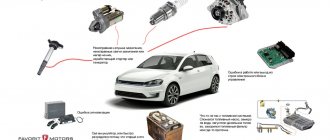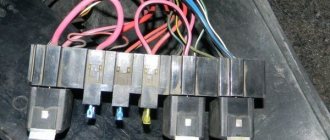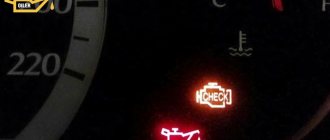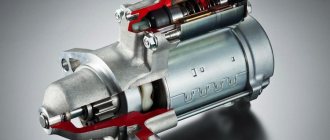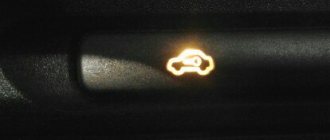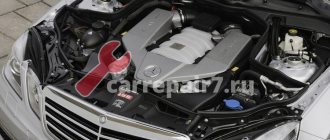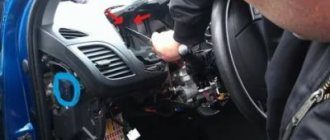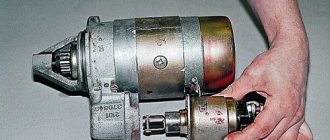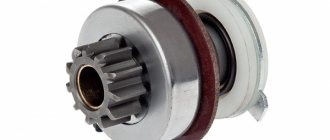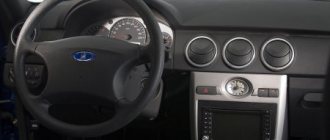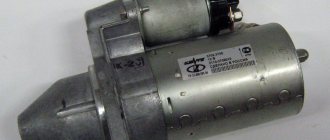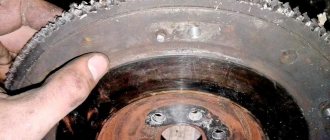Yesterday everything was fine, but today I was tormented by the question of why the starter does not turn on a hot engine. This question may arise from owners of both domestic cars and foreign manufacturers. This phenomenon is very unpleasant, especially for owners of cars with an automatic transmission. In such a situation, a car with a “mechanics” can be started from a tow; sometimes a simple push will be enough to start the engine, but an automatic transmission is not provided for this kind of action.
Why doesn't the starter turn on a hot engine?
, we will tell you in this article, since this problem is not addressed in the car operating instructions. The story cannot be addressed to any specific model, because the symptoms are the same for all brands of cars. There can be several reasons for such an unpleasant situation for the driver. Conventionally, they can be divided into two categories: engine problems and starter malfunctions. We will try to highlight as many problems with these systems as possible.
For many years, since the appearance of the first “self-propelled strollers,” which later became known as cars, the engine was started by rotating the starting handle. As long as the engine had one or two working cylinders, this was not difficult to do. An increase in the number of cylinders and their volume required a significant increase in effort to start the power unit. Therefore, the efforts of designers were aimed at solving this problem. The result of their work was the invention of the electric starter.
The appearance of such an “assistant” made it possible to start the engine without leaving the car, simply by turning the ignition key or pressing a special button. The starter is a complex electrical device in which the energy accumulated by the battery is converted into rotational movement of the armature. A gear is mounted on the armature shaft, which, when engaged with the engine flywheel, starts it.
Like any complex technical device, the starter can sometimes fail. The failure can be complete or partial, related to the device itself or to the devices serving it. In such cases, engine problems cannot be ruled out, regardless of whether it is carburetor or injection. We will not consider the complete failure of this device, but will focus on its partial problems when starting the engine.
We can say with great confidence that most drivers with driving experience have had to deal with a situation where in the morning, after an overnight stay, the engine starts almost instantly, but when hot it shows no signs of life. Let's look at this situation in more detail. First, let's look at problems with the starter.
As you know from physics courses, bodies tend to heat up when heated. This device was no exception. Thermal expansion of the contact wire with the retractor terminal, especially with loose contacts, leads to loss of contact in this connection. The electrical resistance of such a contact increases to such a value that it is unable to provide sufficient current to the electric motor of the starting device. Because of this, it cannot develop sufficient speed to start the engine confidently.
The culprit may be worn starter bushings, which are made from a copper-graphite alloy that is subject to wear. If the car starter has been in operation for a long period, an excessive gap will form between the shaft and the bushing. When the shaft rotates, it is pressed and engages the stator windings, which makes it difficult and sometimes completely stops the rotation.
The source of problems cannot be excluded from the solenoid relay, in which problems with power contacts occur when overheated. Electricians note repeated cases of failure to solder the coils of the solenoid relay with the terminals for connecting the power supply to them. This “minor” malfunction creates difficulties in eliminating it, since it needs to be removed from the car, which is very difficult.
Also on the list of culprits may be a battery if it has insufficient charge. In a cold state, the compression in the working cylinders of the engine is somewhat underestimated, so the energy of such a battery is sufficient for starting. After the engine warms up to operating temperature, it increases, which creates additional loads on the starter that it is not able to overcome. In some cases, the reason may even be trivial. The culprit may be poorly tightened terminals on the battery or their oxidation.
As you can see, problems with starting a hot engine do exist; there can be many more of them than are touched upon in this article. We tried to tell you why the starter does not turn on a hot engine; this can be used as a basis for troubleshooting and troubleshooting problems. If additional questions suddenly arise, today they can easily be found on the Internet or by reading specialized literature.
Electrical faults
Starter connection diagram
Let's divide possible breakdowns into two parts - those that relate directly to the starter, and those that are related to the supply of voltage to it.
No voltage supply to starter
The reasons for the lack of power supply to the starter may be:
You can read about other car starter malfunctions
- Low battery. Operating the car (including the battery) on short trips, with numerous consumers turned on (headlights, heated steering wheel and seats, heated rear window, etc.) does not help the generator fully restore the battery charge. And the battery itself is perhaps no longer in its first youth. During a cold start, a small force is required to crank the crankshaft since the compression in the cylinders of a cold engine is less, since on a cold engine the gaps between the parts of the connecting rod and piston group are larger. After the engine warms up, the gaps, due to thermal expansion of the parts, decrease, which causes compression (pressure) in the cylinders to increase, and the starter does not turn the hot engine.
- Some cars are characterized by “burning” of the ignition switch contacts when the car does not respond to the ignition key . This “disease” is especially typical for cars that do not have an additional starter relay - it is this that protects the contact group of the ignition switch, preventing excessive sparking of the moving contacts. But, even if such a relay is present, it may also fail. In any case, the starter power circuit can be checked by closing its “positive” contacts with a metal object (screwdriver). If even after this the mechanism does not show “signs of life,” then most likely the starter itself is faulty.
- Be sure to carefully check the power “positive” wire from the battery connected to the solenoid relay. It is quite possible that a poorly tightened terminal on the starter was burnt. Also check the negative wires and their connections to the body and engine.
Malfunction of the starter retractor relay
about direct and reverse battery polarity here
The main reason for the failure of this unit is the failure of contact between the copper “positive” bolts and the contact plate. Over time, carbon deposits appear on their surfaces (due to sparking), disrupting electrical contact. The defect can be eliminated by cleaning or replacing parts, but, unfortunately, the vast majority of solenoid relays have a rolled cover and are therefore practically non-separable. Quite often there is a violation of the contact between the terminal and the wire, as well as “rotting” of this contact.
If Priora does not want to start
When the car does not start and its starter, accordingly, does not turn, then most likely the culprit is the battery. This is indicated by the following additional symptoms:
- the solenoid relay clicks;
- The instrument lights on the panel go out.
The easiest way to test the battery is to turn on the headlights. If they burn weakly, you will have to charge the battery.
When the battery appears to be in good condition, but the car still does not start, feel the cables connected to it. If the ends screwed to the terminals (or the starter itself) are warm, then there is poor contact or oxidation. All this creates increased resistance, stealing battery power.
- unscrew the wires;
- clean the battery leads and terminals themselves;
- return the cables to their place;
- Make sure that the ground on the body and the positive on the starter are securely fastened.
Next, check if there is voltage at the ignition switch. This is done like this:
- disconnect the connector of the cable going from it to the traction relay;
- turn the key to the engine start position;
- measure the voltage at the connector.
When nothing suspicious is found here, go to the Priora traction relay. Power it directly from the battery. It is convenient to use cigarette lighter wires for this.
Connect the minus to the starter housing, and the plus to the corresponding relay terminal. Ideally, the mechanism should start working, that is, its shaft will begin to rotate and the gear will move forward.
If this does not happen, try changing the control element itself and if the result is negative, take on the starter electric motor:
- Leave the negative wire from the battery on the body;
- plus, hook it to the lower contact of the solenoid relay.
Wear of starter bushings
The starter armature rotates, supported by copper-graphite bushings, which are plain bearings. When starting the engine, the front bushing takes on the main load, so it wears out over time. The increased gap between the bushing and the armature shaft results in the armature being pressed against the stator during startup. This, firstly, makes it difficult to rotate, and, secondly, leads to an increase in the current in the windings. As a result, the winding insulation burns, which leads to complete inoperability of the starter.
how to install a start-stop button instead of the ignition switch here
It is better to replace starter bushings in a car service - often reamers are required to adjust their internal diameter. If the starter has a front cover, usually made of aluminum alloy, then, in the absence of skills, it can be split when pressing the bushing. To replace the front starter bushing without a housing, you will need to remove it from the gearbox housing. In addition to the listed faults, defective spare parts may be found during repairs. So, for example, it happens that a purchased new bendix has a gear, teeth or housing made “out of size”, as a result of which the bendix “slips” a little further and rests against the gearbox housing. But such incidents, fortunately, are rare.
This is interesting: Selection of Ngk spark plugs for a car
Various designs
Starters differ in the method of transmitting torque from the electric motor shaft to the bendix. Here you can highlight the classic direct-flow starter, a photo of which is presented in the article. Here the bendix is located directly on the armature shaft. There are also gear starters. Their peculiarity is that there is a gear transmission between the bendix and the motor. These devices are better than direct-flow devices in that, with the same weight and dimensions, they are capable of developing greater torque. More often you can find models with planetary gearboxes. This allows manufacturers not to increase overall dimensions. The planetary gearbox in low-power starters consists of plastic parts. This slightly reduces the resource. However, designs with planetary gearboxes are relatively inexpensive.
Crankshaft wear
The reason why the starter does not turn on a hot engine may also be the crankshaft bearings - liners. Due to wear, oil starvation, poor-quality assembly and increased longitudinal (axial) play of the crankshaft, the liners may wear unevenly, which will give them an “wrong” shape, especially as a result of scoring on the surface. As a result, when the engine cools down, gaps appear between the crankshaft bearing journals and the liners, which makes it easier to crank the engine. When it warms up, the presence of these defects, on the contrary, can lead to complete jamming of the engine. In any case, when operating a car, it is advisable to respond as quickly as possible to its seemingly random “whims”.
Lada won't start when cold
Check how fast the crankshaft spins on your Priora. Too low a speed indicates:
- dead battery;
- hardening of the lubricant.
The absence of any reaction from the motor suggests that the problem lies in:
- fuel system - sometimes condensate freezes there;
- a sensor that monitors the temperature of the antifreeze;
- loss of tightness of nozzles;
- weak compression in the cylinders;
- failure in the on-board computer.
If the car starts unstably in winter, then perhaps there is low-quality gasoline in the Priora tank or a lot of condensate has accumulated. It would also be a good idea to look at the spark plugs and the cables leading to them from the distributor, the ignition unit itself, and the sensor that monitors the oxygen level.
Messages 10
1 Topic by Djin 2014-05-03 22:13:33 (2014-05-03 22:15:12 edited by Djin)
- Djin
- New member
- Inactive
- Registration: 2014-03-20
- Messages: 14 Thanks : 9
- Car: VAZ 21102
Topic: Resolved: Starter does not turn over when engine is warm (after driving)
Good day! The essence of the problem is that when the car is cold it starts, the starter always fires, but when you drive it (i.e. it warms up), turn it off, and start to start the starter does not work. Sometimes it starts 2 times, sometimes it takes 2 minutes to turn the key back and forth and then it locks. If the starter does not operate, the indicators on the instrument panel dim. This was done to solve the problem (it didn’t help): all the terminals on the battery are screwed on and cleaned well; The (+) wiring to the starter is also cleaned and tightly put on. I ask for help and advice. The retractors die.
2 Reply from igorek 2014-05-03 22:41:18
- igorek
- Brother-in-law
- Inactive
- From: Bryansk region g Starodub
- Registration: 2013-05-05
- Messages: 416 Thanks : 191
- Car: VAZ-21102 1.5i-8V Bosch MP7.0H
Re: Resolved: The starter does not turn when the engine is warm (after a trip)
Djin , look at the starter relay, perhaps the contact group in the ignition switch is also what the brain does. also the wiring of the connection point of the chips, the voltage drawdown from the poor contact somewhere, good luck in the search
3 Reply from Sergey VAZ 2111 2014-05-04 15:20:14
- Sergey VAZ 2111
- Connoisseur
- Inactive
- Registration: 2013-11-21
- Messages: 513 Thanks : 145
- Car: VAZ 2111
Re: Resolved: The starter does not turn when the engine is warm (after a trip)
check the wires when the engine is hot.
4 Reply from klimashov.roman 2014-05-05 09:26:41
- klimashov.roman
- Connoisseur
- Inactive
- From: Kasimov
- Registration: 2014-04-21
- Messages: 743 Thanks : 143
- Car: GAZelle 33023 dv 405.22, 2.4 16kl 140hp
Re: Resolved: The starter does not turn when the engine is warm (after a trip)
The contact group is unlikely since the problem is described during heating. The relay might be worth a look. Most likely the retractor or the entire starter itself. I had the same problem, no matter how I treated it, replacing the retractor only gave a temporary effect. Disassembling the starter is the only way you will find out the reason. I struggled with money for a long time, threw away half the cost of the starter and ended up having to buy a new one. If you want, disassemble the retractor itself and look at the spots, if they are burnt, clean them, put everything back and lubricate the starter itself with oil, just don’t pour too much without fanaticism. It should work out
5 Reply from Zloy 2014-05-06 22:01:29 (2014-05-06 22:10:18 edited by Zloy)
- Wicked
- New member
- Inactive
- Registration: 2014-01-20
- Messages: 7 Thanks : 2
- Car: VAZ-21102
Re: Resolved: The starter does not turn when the engine is warm (after a trip)
And who’s stopping you (when it won’t start) to apply + directly from the battery to the starter control contact (after disconnecting the chip from the ignition switch or the starter relay - depending on the year of manufacture of the car). Do this with the ignition on and the gear off. If the car starts, then the starter is normal, look for a problem in the ignition switch or wiring, or in the starter relay if there is one (most cars did not have one).
6 Reply from Serg 2014-05-11 09:18:57
- Serg
- Lada2111.rf fan
- Inactive
- Registration: 2013-07-29
- Messages: 830 Thanks : 363
- Car: 2111 dwg 2114 year 2008
Re: Resolved: The starter does not turn when the engine is warm (after a trip)
The problem is trivial and as old as the world - a hidden defect of the manufacturer - modern starters do not have a starter winding; instead, powerful magnets are installed with a small gap between the armature and the stator; when cold, during further operation this gap is masked and therefore, when the starter is cold, the armature can rotate even to some minimum level. then with warming up the gap is selected by temperature expansion and the armature jams tightly - there are two options: the first is to disassemble and wash the stator (at the same time do maintenance), if the magnet(s) are unstuck then option two. new
7 Reply from Jigull 2014-05-11 21:31:12
- Jigull
- New member
- Inactive
- Registration: 2014-05-11
- Messages: 2 Thanks : 0
- Car: VAZ 21124
Re: Resolved: The starter does not turn when the engine is warm (after a trip)
Why does the starter refuse to turn over a hot engine and what to do about it?
To start the engine normally, various components and mechanisms are used, and if one of them fails, this can cause difficulties for the car owner. One of the most common problems is the inoperability of the starter unit. For what reasons does the starter not turn on hot and what to do in this case? Read about it below.
Starter: device and functions
Before talking about the causes of breakdowns, as well as diagnostic and repair methods, you need to know how the starter works and what tasks it performs. Not all modern car owners know and understand the purpose and design of the starter. So, a starter is usually called a device that converts electricity from a battery into mechanical energy, without which it is impossible to start the engine. The element is a DC electric motor with a special mechanical drive.
In addition to the electric motor, the starter consists of a retractor relay and a bendix. The relay consists of two coils:
- retractor;
- holding.
Sufficient force must be applied to retract the core. Then the two coils can perform the same function.
Cause of malfunction
If the starter does not turn over hot, this may be due to various reasons.
When the starter turns tightly, while ensuring poor starting of the power unit, the problem may lie in the following:
- Battery discharge. If the battery has been in use for more than a year, it can discharge quite quickly, especially if the driver forgets to turn off the equipment after parking the car. Therefore, if starting a hot engine causes difficulties, the first thing you should pay attention to is the battery.
- The starter turns poorly when cold or hot as a result of wear on its brushes or bearings. If the brushes wear out, they will not be able to reach the commutator normally, and accordingly, starting the power unit may be difficult. If the bearings wear out, then as a result of heating the armature may come into contact with the stator, which subsequently leads to a short circuit. And this, in turn, reduces the speed of the unit.
- Poor engine starting when hot may be a consequence of incorrect selection of bearing devices as a result of mechanism repair. When bearings get hot, they can seize. The problem can be solved by unraveling and sanding the elements to the required size.
- In some cases, the starter turns poorly when hot due to the ignition switch. In this case, you should initially diagnose the contact group of the device. In order to reduce the likelihood of losses in the electrical circuit of the device, you can additionally install a second relay.
- The retractor relay of the structure has stopped working, this may be indicated by the absence of a click when turning the key in the lock. This element must be replaced, but in addition, it is necessary to diagnose the integrity of the wiring at the solenoid relay terminal. It would be a good idea to visually check the cable between this mechanism and the battery.
- If starting the engine is difficult, but the starter unit is operating normally, the problem may lie in the performance of the power unit. It happens that one of the crankshaft liners gets rubbed as a result of wear, so starting on a cold start is normal, but starting on a hot one is more difficult. This is due to the fact that the liner is clamped by the crankshaft when heated. In some cases, the reason lies in the axial displacement of the shaft itself, which is caused by wear of the axial displacement liners. One way or another, problems of this kind can be solved by repairing the power unit.
Summarizing
It is advisable that the starter spins the engine crankshaft during an attempt to start it for no more than 10 seconds, then the device must be given a minute pause. Failure to comply with this rule will, at best, lead to a discharge of the power source, and at worst, it will completely disable the starter. Only replacing it can save the situation, since not every auto electrician will undertake the task of rewinding burnt windings, since it is not always possible to perform this procedure efficiently. In addition, the cost of this service is comparable to the cost of a new element.
When I turn the ignition key, the car does not start. You can hear clicks and sometimes crunching sounds. You turn the key a few times and the car starts.
Today, when I turned the key, the lights on the instrument panel came on, but the starter did not react at all.
The battery terminals are secure and the battery is new. The starter was disassembled, washed and checked by closing the contacts. No deviations were found. Bosch starter
DIY diagnostics and repairs
So, if the engine refuses to start when hot, you need to diagnose the starter unit. We will tell you more about how to check and repair the device below. The starter mechanism is an electric motor that starts working, receiving energy from the battery. One of the main characteristics of this unit is the consumption of high current at the moment of starting the internal combustion engine, but this only happens for a few seconds. And even then, thanks to the ability of the battery not to discharge.
If the unit does not work well when hot, but all units, mechanisms and circuits are operating normally, it is necessary to repair it. This procedure is not a simple one, so you need to have certain skills and knowledge. As a rule, this unit is mounted in the most inconvenient place for the car owner - at the bottom of the engine. For repairs, prepare standard tools, including a set of wrenches. For greater convenience, you will have to use an extended socket wrench (the author of the video about malfunctions, as well as detailed repairs of the device at home, is the Exin Plus channel).
In any case, you first need to dismantle the mechanism; this procedure is individual for each car, so we will not describe it. After the unit is removed, you need to disassemble its structure. If you do not want to encounter assembly problems after repair, then before disassembling the structure, make the appropriate marks on the body.
This is interesting: Setting up a Solex 21083 carburetor
When disassembling the mechanism, pay attention to the condition of the following elements:
- Nodes and contacts. If you notice that there is a bad contact somewhere, it needs to either be cleaned or replaced. In some cases, stripping can eliminate scorching or oxidation.
- Overrunning clutch or bendix, this component also needs to be carefully checked. Make sure that the component can continue to be used. If the Bendix splines are worn out, then it would be better to change it.
- Anchor. If this component fails, problems with the operation of the motor may occur. The armature is equipped with a commutator, which can burn out as a result of severe wear of the brushes. In addition, no burning of any kind is allowed on the collector, and the same applies to blue plates. At the same stage, the integrity of the windings along with the insulation should be diagnosed.
Also, when this unit is disassembled, it will be necessary to carry out preventive maintenance of all components. All parts without exception must be cleaned of dirt and dust, as this may cause the unit as a whole to malfunction. In the event that the cause of interference in the operation of the mechanism is due to burnt contacts, they must be replaced; if the brushes are worn out or sticking, then you can try to repair them. If the repair does not produce results, then the brush assembly is replaced; for this, you can purchase a special repair kit at any automobile store. In the event that the mechanism simply cannot be repaired, it will need to be replaced with a functional one.
If the need for repairs causes you difficulties, it is better to seek help from specialists. Even if you pay money, you will be confident in the correctness of the actions performed and the functionality of the node.
Bendix
It is needed to engage with the flywheel. The Bendix gear and flywheel cannot be in mesh constantly, since the engine crankshaft speed is much higher than what the electric motor is capable of developing. If the Bendix gear constantly rotates at high speeds, the starter will quickly fail.
Bendixes can be divided into three groups by design:
- The roller clutch is the system that is most commonly found. The principle of operation of this system is based on the jamming of the gear relative to its cage at the moment of rotation in one direction and on free running when rotation occurs in the opposite direction.
- The second group is ratchets. This system operates using a ratchet mechanism. Most often, such bendixes can be found on devices from Delco Remy USA. This design is justified, since these starters have more power.
- The third group of equipment is drives in which engagement is carried out by a package of friction plates. This solution is actively used in Bosch starters of the 0001410 series and others intended for trucks.
The starter turns poorly when hot
Once upon a time, car engines were started manually, spinning them using a special tool. The design of modern engines makes the driver's work easier. Now you don’t need to get out of the car and make great efforts to start the engine; just turn the key in the ignition and the starter will do everything.
With the advent of the starter, new problems appeared when starting the car. There are situations when you need to drive off, but the engine stubbornly won’t start because the starter refuses to rotate. In addition, there are a number of situations when the engine is well warmed up, but the starter still does not rotate. This leaves drivers with a serious question, one to which not everyone knows the answer. Let's try to figure out why the starter turns poorly when hot.
Main reasons and ways to solve them
Lada Priora 16 valves is a car created on the basis of innovative technologies borrowed from foreign concerns, so the technical side provides different functionality. Another important property is that all parts are original, so if necessary, the consumer can easily carry out repair work.
The reasons why a car does not start may differ depending on external influences, namely the lack of starting torque in cold weather, due to technical problems, and so on.
Starter failures and their solutions
If the starter does not turn and the car engine does not start, then the following breakdowns and ways to eliminate them can be identified.
As a rule, a detailed examination of the starter system and related structures provides an opportunity to identify the problem and efficiently eliminate it. Sometimes the malfunction is a combination of several breakdowns, for example, the battery is discharged and the terminals have come loose. Therefore, it is important to pay close attention to all the details.
The starter works, but the engine does not start
If the starter turns for a long time, but the engine does not start, or the car does not start well without gas, then in this case we can talk about the presence of malfunctions on the part of the motor or in the circuit leading to the starter. And sometimes the reasons are more primitive: lack of fuel, battery discharge, broken connections or their deviation from the established places. Careful consideration of the causes of such a malfunction, methods of diagnosis and elimination allows you to achieve the goal in terms of restoring functionality.
We recommend: Why there is no spark on the spark plugs: troubleshooting in the car ignition system
As a rule, owners of a Lada Priora, both cold and hot, most often encounter a break or damage to the system leading from the starter to the engine, so the engine does not seize and does not start. This will eliminate the problem without spreading it in the form of breakdown of additional elements.
Causes of poor starter rotation
The reasons for the slow rotation of the starter when hot can be:
- Low battery charge. This is one of the first reasons for poor starter performance. It happens that a forgetful motorist, getting out of the car, forgets to turn off some of the electrical appliances, for example, daytime running lights. The battery is discharged and then, when you try to start the car, the starter either does not turn at all or turns very slowly.
- Incorrect ignition timing. To verify this, you can disconnect the wire from the relay coil and try to spin the crankshaft without a spark. If rotation occurs without much effort, this means that the ignition timing is too early.
- Natural wear of brushes or brass bushings (bearings). When the graphite brushes wear out, their contact with the engine commutator becomes poor. Due to poor contact, the starter rotor begins to rotate either too slowly or stops showing signs of life altogether. In the case of bushings, there is a violation of their alignment. The shaft warps, and the stator poles begin to touch the armature poles, thus forming friction. As a result of friction, the speed of rotation of the armature decreases and it becomes insufficient to start the car engine.
- It is quite possible that during the last repair work, the starter bushings were selected incorrectly, or even installed incorrectly. In this case, it is necessary to replace them.
- Ignition switch problem. This device also has its own problems of supplying a bad pulse to the excitation winding. This mainly applies to cars that do not have a starter relay installed. It allows you to reduce current losses as they pass through the contact group of the ignition switch.
- Solenoid relay malfunction. Usually manifests itself as a lack of a click when the starter is turned on. Usually, the relay is replaced. Check the wires going to the solenoid relay, they are probably broken. There may also be contact contamination that needs to be removed.
- Crankshaft problems. Its alignment is disturbed or one of the liners, which is pressed when the entire shaft is heated, has worn out. Jamming of the piston group also occurs. In any case, only engine repair will help here.
Units and design details
The function of the starter is to start the car engine by spinning its flywheel with an electric motor, creating temporary contact between the gears. Subsequently, the electric motor is turned off and physical contact with the flywheel gear is broken. The starter is located on the engine body closer to the battery and the cab.
Structurally, the device can be divided into two functional blocks:
Solenoid relay. When 12 volts are applied directly to the control contact, the electromagnet pulls in the core. The core pushes the bendix through a lever to engage the gear with the flywheel teeth. At the final point of retraction, the armature, with a contact plate through the rod, closes the contact of the nickels, providing a direct connection of the electric motor to the “+” of the battery.- Electric motor. When voltage is applied, it begins to rotate, spinning the flywheel through the Bendix to the operating speed of the car engine.
After starting the engine, the key is returned from the ignition position, de-energizing the relay. The relay opens the contacts, the spring returns the bendix to its original state. When starting, the electric motor requires several tens of amperes of current from the battery. After starting the car engine, the generator restores the battery charge.
The starter may have malfunctions, determined by the nature of the manifestation, visible signs, and tester readings.
Engine starting system problems. Slow starter rotation
According to the diagram, the starting system is a starter, to which two wires are connected. One originates from the battery positive, passes through the ignition switch and is connected to the corresponding contact on the starter housing. The second wire originates from the vehicle ground (negative) and is connected to the starter housing. A fuse is connected between the ignition switch and the starter contact. It protects the electrical circuit from possible short circuits.
During operation, all wire connections tend to oxidize or corrode. As a result, the contact disappears, and the starter begins to work with frequent interruptions: it turns slowly or does not always start. In this case, it is necessary to regularly clean the contacts from traces of corrosion and oxidation.
Procedure for cleaning contact connections:
- Disconnect the battery terminals and wires that connect to the starter.
- Clean the surfaces of the terminals and contacts with sandpaper.
- Treat cleaned areas with gasoline or alcohol solution.
- Apply lithol or graphite to the connections and connect all the wires back.
If there is a short circuit, a fuse is triggered, which will indicate a malfunction with a melted insert. First, find the short circuit, eliminate it and replace the fuse. All work may only be carried out with the battery terminal removed.
Common types of starter failures
The above reasons allow us to identify the following starter failures:
- oxidation of battery terminals or poor fastening of wire tips;
- short circuit or burnout of the starter relay winding;
- violation of the integrity of the power supply chain;
- malfunction of the switching relay;
- defects in graphite brushes.
